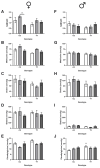Folic Acid and Methyltetrahydrofolate Supplementation in the Mthfr677C>T Mouse Model with Hepatic Steatosis
- PMID: 39796516
- PMCID: PMC11723006
- DOI: 10.3390/nu17010082
Folic Acid and Methyltetrahydrofolate Supplementation in the Mthfr677C>T Mouse Model with Hepatic Steatosis
Abstract
Background/objectives: The MTHFR677C>T gene variant results in a thermolabile MTHFR enzyme associated with elevated plasma homocysteine in TT individuals. Health risks associated with the TT genotype may be modified by dietary and supplemental folate intake. Supplementation with methyltetrahydrofolate (methylTHF) may be preferable to folic acid because it is the MTHFR product, and does not require reduction by DHFR to enter one-carbon folate metabolism. In the Mthfr677C>T mouse model for this variant, female 677TT (TT) mice have an increased incidence of hepatic steatosis. The objective of this study was to compare the effects of methylTHF and folic acid supplementation on hepatic steatosis and one-carbon metabolism in this model.
Methods: Male and female C57BL/6J 677CC (CC) and TT mice were fed control (CD), 5xmethylTHF-supplemented (MFSD), or 5xfolic-acid-supplemented (FASD) diets for 4 months. Liver sections were assessed for steatosis by Oil Red O staining. One-carbon metabolites were measured in the liver and plasma. MTHFR protein expression was evaluated in the liver.
Results: MFSD had no significant effect on plasma homocysteine, liver SAM/SAH ratios, or hepatic steatosis in males or females as compared to CD. MTHFR protein increased in MFSD TT female liver, but remained <50% of the CC. FASD had no effect on plasma homocysteine but it decreased the liver MTHFR protein and SAM/SAH ratios, and increased hepatic steatosis in CC females.
Conclusions: MethylTHF and folic acid supplementation had limited benefits for TT mice, while folic acid supplementation had negative effects on CC females. Further investigation is required to determine if these effects are relevant in humans.
Keywords: MTHFR; folic acid; hepatic steatosis; methyltetrahydrofolate; mouse model; supplementation.
Conflict of interest statement
The authors declare no conflicts of interest.
Figures






Similar articles
-
Low Dietary Folate Increases Developmental Delays in the Litters of Mthfr677TT Mice.Nutrients. 2025 Aug 1;17(15):2536. doi: 10.3390/nu17152536. Nutrients. 2025. PMID: 40806120 Free PMC article.
-
Folate Deficiency and/or the Genetic Variant Mthfr677C >T Can Drive Hepatic Fibrosis or Steatosis in Mice, in a Sex-Specific Manner.Mol Nutr Food Res. 2024 Mar;68(5):e2300355. doi: 10.1002/mnfr.202300355. Epub 2024 Feb 7. Mol Nutr Food Res. 2024. PMID: 38327171
-
MTHFR 677C->T genotype is associated with folate and homocysteine concentrations in a large, population-based, double-blind trial of folic acid supplementation.Am J Clin Nutr. 2011 Jun;93(6):1365-72. doi: 10.3945/ajcn.110.004671. Epub 2011 Apr 20. Am J Clin Nutr. 2011. PMID: 21508090 Clinical Trial.
-
Meta-analysis of MTHFR 677C->T polymorphism and coronary heart disease: does totality of evidence support causal role for homocysteine and preventive potential of folate?BMJ. 2005 Nov 5;331(7524):1053. doi: 10.1136/bmj.38611.658947.55. Epub 2005 Oct 10. BMJ. 2005. PMID: 16216822 Free PMC article. Review.
-
Methylenetetrahydrofolate Reductase Deficiency.2012 Mar 8 [updated 2024 Nov 4]. In: Pratt VM, Scott SA, Pirmohamed M, Esquivel B, Kattman BL, Malheiro AJ, editors. Medical Genetics Summaries [Internet]. Bethesda (MD): National Center for Biotechnology Information (US); 2012–. 2012 Mar 8 [updated 2024 Nov 4]. In: Pratt VM, Scott SA, Pirmohamed M, Esquivel B, Kattman BL, Malheiro AJ, editors. Medical Genetics Summaries [Internet]. Bethesda (MD): National Center for Biotechnology Information (US); 2012–. PMID: 28520345 Free Books & Documents. Review.
Cited by
-
Low Dietary Folate Increases Developmental Delays in the Litters of Mthfr677TT Mice.Nutrients. 2025 Aug 1;17(15):2536. doi: 10.3390/nu17152536. Nutrients. 2025. PMID: 40806120 Free PMC article.
References
-
- Zhao L., Li T., Dang M., Li Y., Fan H., Hao Q., Song D., Lu J., Lu Z., Jian Y., et al. Association of methylenetetrahydrofolate reductase (MTHFR) rs1801133 (677C>T) gene polymorphism with ischemic stroke risk in different populations: An updated meta-analysis. Front. Genet. 2022;13:1021423. doi: 10.3389/fgene.2022.1021423. - DOI - PMC - PubMed
MeSH terms
Substances
Grants and funding
LinkOut - more resources
Full Text Sources
Medical

